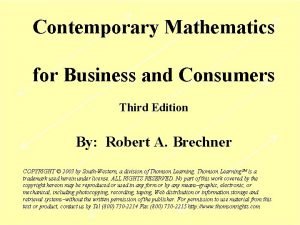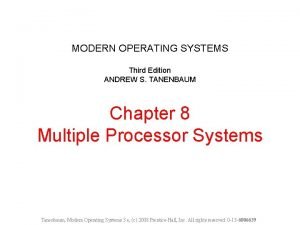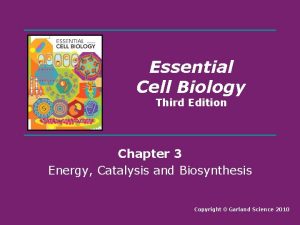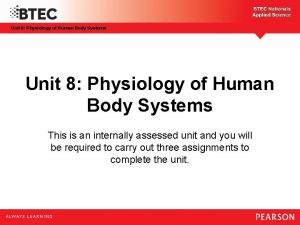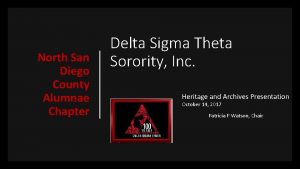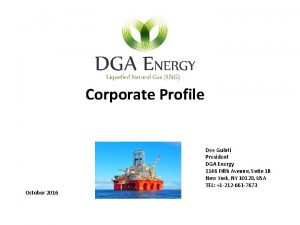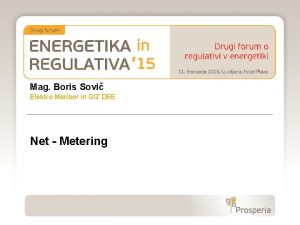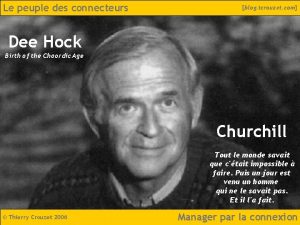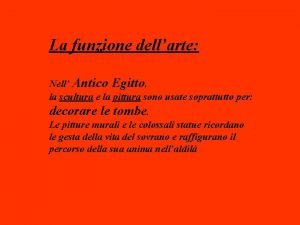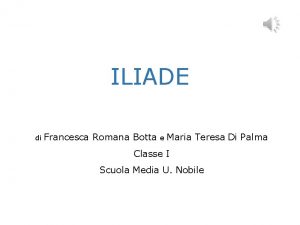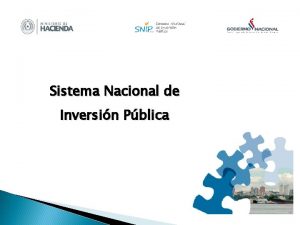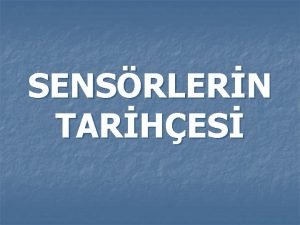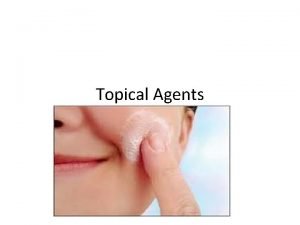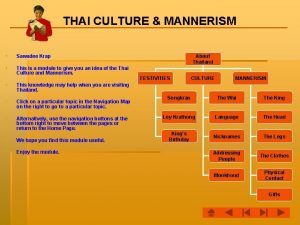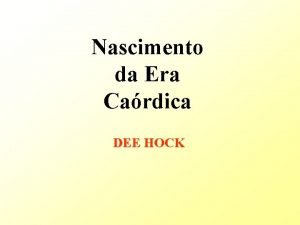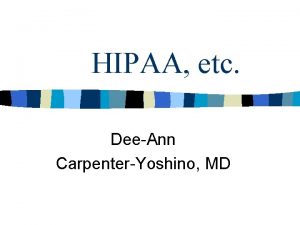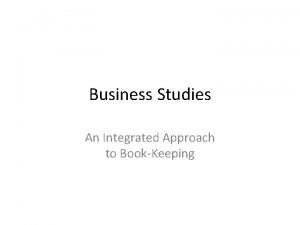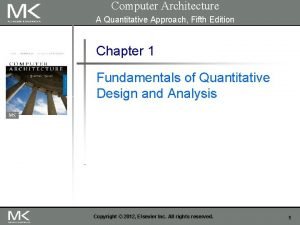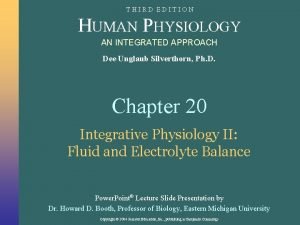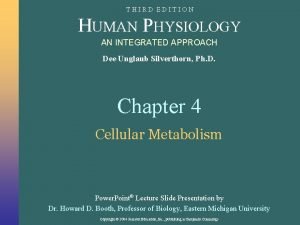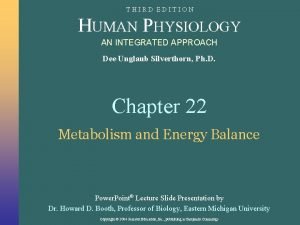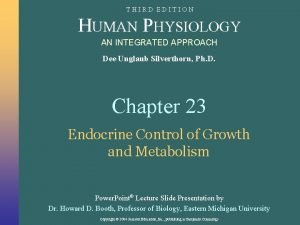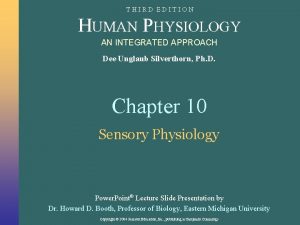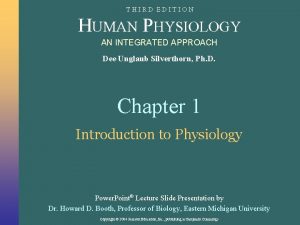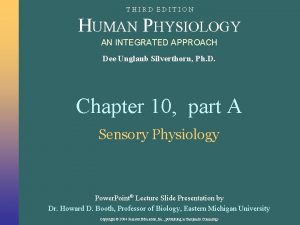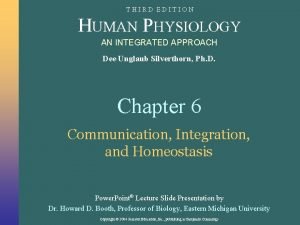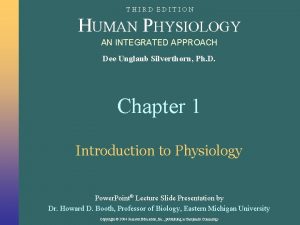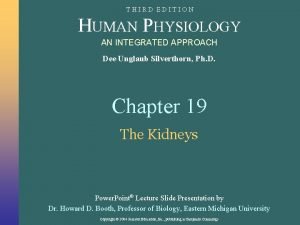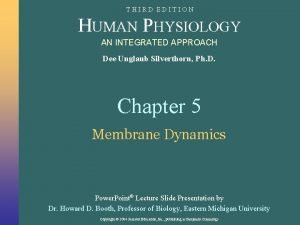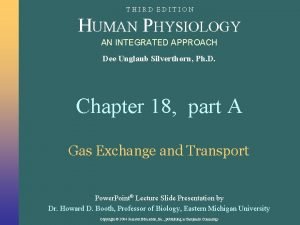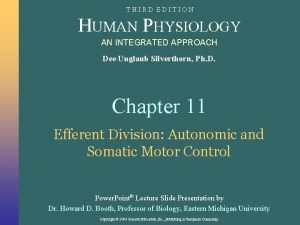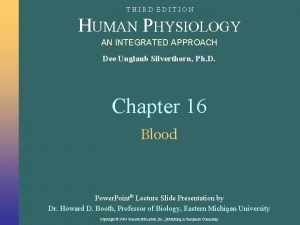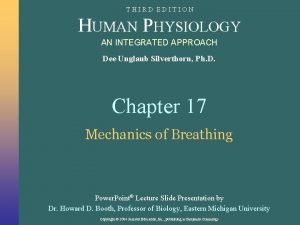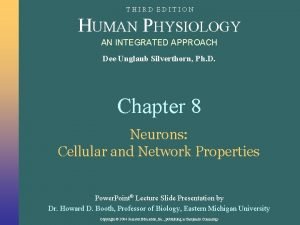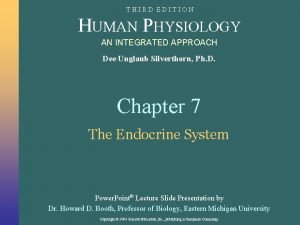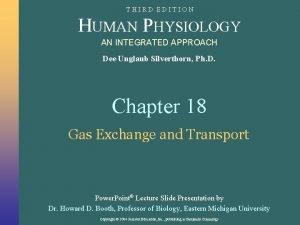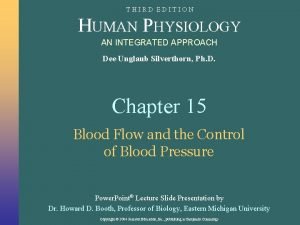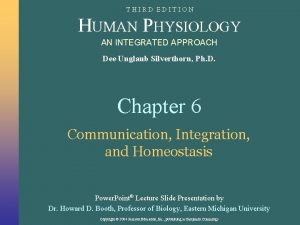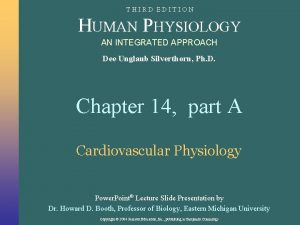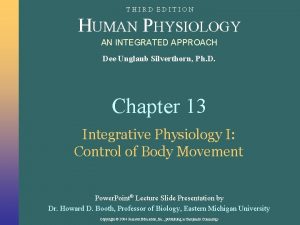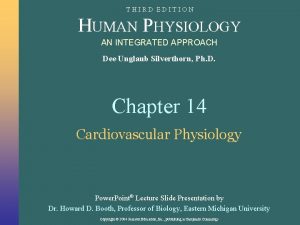THIRD EDITION HUMAN PHYSIOLOGY AN INTEGRATED APPROACH Dee























































- Slides: 55

THIRD EDITION HUMAN PHYSIOLOGY AN INTEGRATED APPROACH Dee Unglaub Silverthorn, Ph. D. Chapter 15 Blood Flow and the Control of Blood Pressure Power. Point® Lecture Slide Presentation by Dr. Howard D. Booth, Professor of Biology, Eastern Michigan University Copyright © 2004 Pearson Education, Inc. , publishing as Benjamin Cummings

About this Chapter • How various blood vessels are constructed and role in circulation • Components of "blood pressure", role and measurement • Product exchange at the capillary beds • Lymph vessels, distribution and role in circulation • How blood pressure and circulation are regulated • Key components of cardiovascular disease Copyright © 2004 Pearson Education, Inc. , publishing as Benjamin Cummings

The Blood Vessels and the Cardiovascular System • Arteries: blood from heart • Strong & Elastic • Conduct blood to capillaries • Sphincters • Capillaries: exchange with cells • Veins • Return blood to heart • Valves Copyright © 2004 Pearson Education, Inc. , publishing as Benjamin Cummings

The Blood Vessels and the Cardiovascular System Figure 15 -1: Functional model of the cardiovascular system Copyright © 2004 Pearson Education, Inc. , publishing as Benjamin Cummings

Make Up of Blood Vessels: Arteries and Arterioles • Endothelium • Elastic tissues • Rebounds • Evens flow • Smooth muscles • Fibrous tissue • Tough • Resists stretch Copyright © 2004 Pearson Education, Inc. , publishing as Benjamin Cummings Figure 15 -2: Blood vessels

Make Up of Blood Vessels: Capillaries • Endothelium: one cell thick • Continuous • Fenestrated • Basement membrane Copyright © 2004 Pearson Education, Inc. , publishing as Benjamin Cummings

Make Up of Blood Vessels: Capillaries Copyright © 2004 Pearson Education, Inc. , publishing as Benjamin Cummings Figure 15 -16: Types of capillaries

Make Up of Blood Vessels: Veins and Venules (Contrasted to Arteries) • Thinner walls • Larger diameter • Closer to skin • Less muscle • Less elastic Copyright © 2004 Pearson Education, Inc. , publishing as Benjamin Cummings Figure 15 -3: Metarterioles

Angiogenesis: Growth of New Blood Vessels • Normal body maturation and growth • Endometrium • Endurance training • Abnormal growth to service cancerous tissue • Wound repair and consequences • Failure to regrow in heart tissues after heart attack • Failure to regrow in brain after stroke Copyright © 2004 Pearson Education, Inc. , publishing as Benjamin Cummings

Blood Pressure: Generated by Ventricular Contraction • Pulsatile: surges in arteries • Elastic rebound evens & maintains pressure Copyright © 2004 Pearson Education, Inc. , publishing as Benjamin Cummings

Blood Pressure: Generated by Ventricular Contraction Figure 15 -4: Elastic recoil in the arteries Copyright © 2004 Pearson Education, Inc. , publishing as Benjamin Cummings

Blood Pressure (BP): Measurements • "Blood pressure" • Systolic over diastolic • About 120/80 mm. Hg • Sphygmomanometer • "Estimate of pressure" • Korotkoff sounds Copyright © 2004 Pearson Education, Inc. , publishing as Benjamin Cummings

Blood Pressure (BP): Measurements Figure 15 -7: Measurement of arterial blood pressure Copyright © 2004 Pearson Education, Inc. , publishing as Benjamin Cummings

More Blood Pressures: Pulse and Mean Arterial Pressures • Pulse pressure = Systolic–Diastolic • Mean arterial pressure (MAP) = Diastolic + 1/3 pulse pressure Copyright © 2004 Pearson Education, Inc. , publishing as Benjamin Cummings

More Blood Pressures: Pulse and Mean Arterial Pressures Figure 15 -5: Pressure throughout the systemic circulation Copyright © 2004 Pearson Education, Inc. , publishing as Benjamin Cummings

Factors Controlling MAP : The Driving Pressure for Blood Flow • Blood volume • Cardiac output • Resistance • Distribution Copyright © 2004 Pearson Education, Inc. , publishing as Benjamin Cummings

Factors Controlling MAP : The Driving Pressure for Blood Flow Figure 15 -10: Factors that influence mean arterial pressure Copyright © 2004 Pearson Education, Inc. , publishing as Benjamin Cummings



Antihypertensive Drug Classes: Action Sites Blood Pressure = Cardiac Output A n t i h y p ert en s i v e Dru g C l a s s es -Blockers Total Peripheral Resistance -Blockers ACE Inhibitors AT 1 Blockers Direct renin inhibitors 1 -Blockers Non-DHP CCBs 2 -Agonists Diuretics All CCBs Sympatholytics Vasodilators ACE = angiotensin-converting enzyme; AT 1 = angiotensin type 1; CCBs = calcium channel blockers; DHP = dihydropyridine Slide Source Hypertension Online www. hypertensiononline. org

Classes of Antihypertensive Drugs • Aldosterone receptor antagonists (blockers) • Angiotensin II antagonists • Angiotensin-converting enzyme inhibitors • -Blockers – 1 -Selective – Nonselective • -Blockers – -1/ -2 – -1 predominant – / – Intrinsic sympathomimetic activity • Calcium channel antagonists – Nondihydropyridine – Dihydropyridine • Central 2 agonists • Direct renin inhibitors • Direct vasodilators • Diuretics – Thiazide-type – Loop-type – Potassium-sparing • Ganglionic blockers Slide Source Hypertension Online www. hypertensiononline. org

Arteriole Resistance: Control of Local Blood Flow • Myogenic auto regulation • Paracrines: • Hyperemia • Sympathetic nerves – CNS Copyright © 2004 Pearson Education, Inc. , publishing as Benjamin Cummings

Distribution of Blood in the Body Organs Copyright © 2004 Pearson Education, Inc. , publishing as Benjamin Cummings Figure 15 -13: Distribution of blood in the body at rest

Capillary Blood Flow: Greatest Total Cross Sectional Area • Lowest Velocity • Hydrostatic pressure drops Copyright © 2004 Pearson Education, Inc. , publishing as Benjamin Cummings Figure 15 -17: The velocity of flow depends on the total crosssectional area

Capillary Exchange: Colloidal Osmotic Pressure is Constant • Proteins stay in capillary • Water, oxygen, glucose – move out • CO 2, N wastes, water – move in • Bulk flow out on arterial side, in on venous side Copyright © 2004 Pearson Education, Inc. , publishing as Benjamin Cummings

Capillary Exchange: Hydrostatic Pressure Declines • High on arterial side – bulk flow out • Low on venous side – bulk flow in • Fenestrations &/or leaky joints speed exchange Copyright © 2004 Pearson Education, Inc. , publishing as Benjamin Cummings Figure 15 -18 a: Fluid exchange at the capillary

Net Out Flow Into ECF • Net filtration – net absorption = net out flow • About 2 L/day collected by lymph vessels Copyright © 2004 Pearson Education, Inc. , publishing as Benjamin Cummings Figure 15 -18 b: Fluid exchange at the capillary

Lymphatic System: Structure and Roles (overview) • Lymphatic structures • Capillaries with valves • Lymph vessels • Lymph nodes & organs • Immune defense: lymphocytes • Transport of fats • Collects excess ECF • Returns to plasma • Edema Copyright © 2004 Pearson Education, Inc. , publishing as Benjamin Cummings

Lymphatic System: Structure and Roles (overview) Copyright © 2004 Pearson Education, Inc. , publishing as Benjamin Cummings Figure 15 -19: The lymphatic system

Lymphatic System: Overview • Consists of two semi-independent parts • A meandering network of lymphatic vessels • Lymphoid tissues and organs scattered throughout the body • Returns interstitial fluid and leaked plasma proteins back to the blood • Lymph – interstitial fluid once it has entered lymphatic vessels Copyright © 2004 Pearson Education, Inc. , publishing as Benjamin Cummings

Figure 20. 2 a Copyright © 2004 Pearson Education, Inc. , publishing as Benjamin Cummings

Lymphatic System: Overview Figure 20. 1 a Copyright © 2004 Pearson Education, Inc. , publishing as Benjamin Cummings

Lymphatic Capillaries • Similar to blood capillaries, with modifications • Remarkably permeable • Loosely joined endothelial minivalves • Withstand interstitial pressure and remain open • The minivalves function as one-way gates that: • Allow interstitial fluid to enter lymph capillaries • Do not allow lymph to escape from the capillaries Copyright © 2004 Pearson Education, Inc. , publishing as Benjamin Cummings

Lymphatic Capillaries • During inflammation, lymph capillaries can absorb: • Cell debris • Pathogens • Cancer cells • Cells in the lymph nodes: • Cleanse and “examine” this debris • Lacteals – specialized lymph capillaries present in intestinal mucosa • Absorb digested fat and deliver chyle to the blood Copyright © 2004 Pearson Education, Inc. , publishing as Benjamin Cummings

Lymphatic Trunks • Lymph is delivered into one of two large trunks • Right lymphatic duct – drains the right upper arm and the right side of the head and thorax • Thoracic duct – arises from the cisterna chyli and drains the rest of the body Copyright © 2004 Pearson Education, Inc. , publishing as Benjamin Cummings

Lymph Transport • The lymphatic system lacks an organ that acts as a pump • Vessels are low-pressure conduits • Uses the same methods as veins to propel lymph • Pulsations of nearby arteries • Contractions of smooth muscle in the walls of the lymphatics Copyright © 2004 Pearson Education, Inc. , publishing as Benjamin Cummings

Regulation of Blood Pressure and Heart Rate • Medullary cardiac control center (Brainstem) • Cardioacceleratory Center • Cardioinhibitory Center • Baroreceptor reflex • Carotid • Aortic • Kidney: blood volume • Hypothalamus & Cortex: stress, blushing, etc. Copyright © 2004 Pearson Education, Inc. , publishing as Benjamin Cummings

Copyright © 2004 Pearson Education, Inc. , publishing as Benjamin Cummings

Copyright © 2004 Pearson Education, Inc. , publishing as Benjamin Cummings

Copyright © 2004 Pearson Education, Inc. , publishing as Benjamin Cummings

Copyright © 2004 Pearson Education, Inc. , publishing as Benjamin Cummings

Copyright © 2004 Pearson Education, Inc. , publishing as Benjamin Cummings

Copyright © 2004 Pearson Education, Inc. , publishing as Benjamin Cummings

Copyright © 2004 Pearson Education, Inc. , publishing as Benjamin Cummings

Copyright © 2004 Pearson Education, Inc. , publishing as Benjamin Cummings

Regulation of Blood Pressure Figure 15 -22: The baroreceptor reflex: the response to increased blood pressure Copyright © 2004 Pearson Education, Inc. , publishing as Benjamin Cummings

Copyright © 2004 Pearson Education, Inc. , publishing as Benjamin Cummings

Copyright © 2004 Pearson Education, Inc. , publishing as Benjamin Cummings

Copyright © 2004 Pearson Education, Inc. , publishing as Benjamin Cummings

Copyright © 2004 Pearson Education, Inc. , publishing as Benjamin Cummings

Cardiovascular Diseases: #1 killer • Risk Factors: • Smoking • Obesity • Diabetes • Genes • Diseases: • Hypertension • Stroke • "Heart Attack" Copyright © 2004 Pearson Education, Inc. , publishing as Benjamin Cummings

Mechanism of Atherosclerosis • LDL build up • Plaque • Flow • Rupture • Clot • Blocked flow • Tissue death Copyright © 2004 Pearson Education, Inc. , publishing as Benjamin Cummings

How Atherosclerosis Develops We now understand that atherosclerosis is a chronic inflammation of arteries, which develops over decades in response to the biologic effects of risk factors. Atherogenesis begins as a qualitative change to intact endothelial cells; when subjected to oxidative, hemodynamic, or biochemical stimuli (from smoking, hypertension, or dyslipidemia) and inflammatory factors, they change their permeability to promote the entry and retention of blood-borne monocytes and cholesterol-containing LDL particles. Inflammation and biochemical modifications ensue, causing endothelial and smooth-muscle cells to proliferate, produce extracellular matrix molecules, and form a fibrous cap over the developing atheromatous plaque. Plaques lead to clinical symptoms by producing flow-limiting stenoses (causing stable angina) or by provoking thrombi that interrupt blood flow on either a temporary basis (causing unstable angina) or a permanent one (causing myocardial infarction). Physical disruption (rupture) of the plaque exposes procoagulant material within the core of the plaque to coagulation proteins and platelets, triggering clotting. Copyright © 2004 Pearson Education, Inc. , publishing as Benjamin Cummings

Summary • Blood vessels, anatomy & role in circulation • Measuring blood pressures, MAP & pulse pressure • Role of resistance in BP and distribution of blood • Autoregulation, baroreceptros, medullary cardiac control center and CNS regulation of blood pressure & distribution Copyright © 2004 Pearson Education, Inc. , publishing as Benjamin Cummings

Summary • Hydrostatic & colloidal osmotic pressures direct bulk flow in capillary exchange by diffusion, fenestrations & leaky joints • Role of lymphatic system to return excess ECF to plasma • Atherosclerosis common to several cardiovascular diseases Copyright © 2004 Pearson Education, Inc. , publishing as Benjamin Cummings
 3 layers of muscle
3 layers of muscle Paratubular cyst
Paratubular cyst Anatomy and physiology edition 9
Anatomy and physiology edition 9 Physiology of sport and exercise 5th edition
Physiology of sport and exercise 5th edition Finns modification of cavity preparation
Finns modification of cavity preparation Forward caries and backward caries
Forward caries and backward caries What is the third step in integrated pest management?
What is the third step in integrated pest management? Principles of economics third edition pdf
Principles of economics third edition pdf Reaction of grignard reagent with acid chloride
Reaction of grignard reagent with acid chloride Organic chemistry third edition david klein
Organic chemistry third edition david klein Business mathematics third edition
Business mathematics third edition Modern operating systems tanenbaum
Modern operating systems tanenbaum Fundamentals of corporate finance third canadian edition
Fundamentals of corporate finance third canadian edition Sujata madan
Sujata madan Lifespan development third edition
Lifespan development third edition Lifespan development third edition
Lifespan development third edition Essential cell biology
Essential cell biology Graphical display
Graphical display Advertising and integrated brand promotion 8th edition
Advertising and integrated brand promotion 8th edition Waistline
Waistline Unit 8 physiology of human body systems
Unit 8 physiology of human body systems Animal physiology exam 1
Animal physiology exam 1 Holes essential of human anatomy and physiology
Holes essential of human anatomy and physiology Distal and proximal
Distal and proximal Chapter 2 human reproductive anatomy and physiology
Chapter 2 human reproductive anatomy and physiology Using mis 10th edition
Using mis 10th edition Using mis (10th edition)
Using mis (10th edition) Dee magnoni
Dee magnoni Frankie dee brown
Frankie dee brown Dee ward hock
Dee ward hock Dee gulati
Dee gulati Artvnow
Artvnow Tamara williams nude
Tamara williams nude Giz dee
Giz dee Dee ward hock
Dee ward hock Micerino tra due dee
Micerino tra due dee Dac dee fly
Dac dee fly Dee childs
Dee childs Dee reul
Dee reul Klein anna zat op blauwe steen
Klein anna zat op blauwe steen Dee kay buildcon pvt ltd
Dee kay buildcon pvt ltd Tre dee alla scuola media riassunto
Tre dee alla scuola media riassunto Dr david glaser
Dr david glaser Casperwww.
Casperwww. Preinversion
Preinversion Lew hewitt
Lew hewitt Topical agents are
Topical agents are Jane dee hull elementary
Jane dee hull elementary Sawadee definition
Sawadee definition Dee hock
Dee hock Dr dee-ann carpenter
Dr dee-ann carpenter Dee trader opens a brokerage account
Dee trader opens a brokerage account Dee simmons young
Dee simmons young An integrated approach to business studies
An integrated approach to business studies Computer architecture 5th edition
Computer architecture 5th edition Computer architecture a quantitative approach sixth edition
Computer architecture a quantitative approach sixth edition










